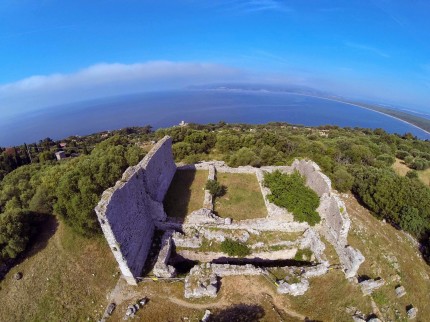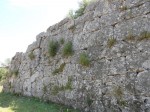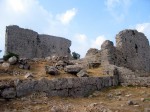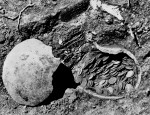Last month’s discovery of a hoard with a name scratched in the pot in Bulgaria was a first for me, but that’s just because I didn’t know about the hoard of Republican Roman silver denarii discovered in the 1960s in the archaeological site of Cosa, near modern-day Ansedonia in southern Tuscany.

Cosa was a Latin colonia founded in 273 B.C. on a hill overlooking the Tyrrhenian Sea. It was a small town of about 13 hectares enclosed by a wall built out of massive polygonal limestone blocks between 273 and 264 B.C. The wall was studded with 18 square towers and three gates which opened onto the main streets of the city. Cosa was designed on an octagonal grid system modified to accommodate the rollercoaster topography of the town: two peaks with a valley between. An arx (citadel) was built on the highest peak inside the walls. This was the religious zone whose most ancient temple was the Auguraculum where auspices were taken. Two other temples were built in the 3rd and 2nd centuries, dedicated to Jupiter and Mater Matuta. The temple of Jupiter was replaced in the second quarter of the 2nd century with the Capitolium, a temple dedicated to the Capitoline Triad (Jupiter, Juno, Minerva) modeled after the one in Rome.
 From the Capitolium a broad street leads straight to the civic center of the town, a long rectangular piazza accessed by a monumental arch built around 170 B.C. and flanked on three sides by porticoes and surrounded by water channels. This is where you find Cosa’s main public buildings: the forum, the Comitium Curiae where the popular assembly met to vote, pass laws and hold court, the carcer or public prison, the Forum Piscarium where cisterns were built to hold fish for the city’s market. From 197 to 150 B.C., the forum saw a burst of development with the addition of eight commercial atria with shopfronts opening on the piazza, central pool and side rooms. A colonnaded basilica for judiciary use was also built during this period, as was a small temple possibly dedicated to Concordia.
From the Capitolium a broad street leads straight to the civic center of the town, a long rectangular piazza accessed by a monumental arch built around 170 B.C. and flanked on three sides by porticoes and surrounded by water channels. This is where you find Cosa’s main public buildings: the forum, the Comitium Curiae where the popular assembly met to vote, pass laws and hold court, the carcer or public prison, the Forum Piscarium where cisterns were built to hold fish for the city’s market. From 197 to 150 B.C., the forum saw a burst of development with the addition of eight commercial atria with shopfronts opening on the piazza, central pool and side rooms. A colonnaded basilica for judiciary use was also built during this period, as was a small temple possibly dedicated to Concordia.
The northwest sector of the city was the residential neighborhood. In the 3rd and 2nd centuries B.C., most of the houses were a standard size — one block each — with living space on a second storey and modest garden space behind, both floors surrounding a central atrium. About 20 of the 248 private homes were double the size. They were reserved for the decurions, the city senators. In the early 1st century A.D., larger, more luxurious homes were built next to the forum. They are characterized by fine mosaic floors and frescoed walls and an extensive garden. The house of Quintus Fulvius is one of these luxury homes.
 Cosa was sacked around 70 B.C., possibly by Tyrrhenian pirates like the ones turned into dolphins by Dionysus when they tried to kidnap him. The town was rebuilt under Augustus Caesar and was occupied at least until the 3rd century. By the early 5th century, it was in ruins. Rutilius Claudius Namatianus, a poet of the late imperial era, mentioned it in the elegiac poem De Reditu Suo documenting his sea voyage home to Gaul from Rome in 416 A.D.:
Cosa was sacked around 70 B.C., possibly by Tyrrhenian pirates like the ones turned into dolphins by Dionysus when they tried to kidnap him. The town was rebuilt under Augustus Caesar and was occupied at least until the 3rd century. By the early 5th century, it was in ruins. Rutilius Claudius Namatianus, a poet of the late imperial era, mentioned it in the elegiac poem De Reditu Suo documenting his sea voyage home to Gaul from Rome in 416 A.D.:
Then we descry, all unguarded now, desolate Cosa’s ancient ruins and unsightly walls. ‘Tis with a qualm that I adduce mid serious things the comic reason for its downfall; but I am loath to suppress a laugh. The story runs that once upon a time the townsfolk were forced to migrate and left their homes behind because rats infested them! I’d sooner believe in losses suffered by the Pygmies’ infantry and in cranes leagued solemnly to fight their wars.
There is archaeological evidence — pottery, post-imperial construction — of a very reduced human presence in Cosa even after the urban legendary plague of rats, but even that stops by the 7th century at the latest.
 The American Academy in Rome began excavating the ruins in 1948, reaching the larger homes in the mid-1960s. The domus had been partially reconstructed in the 1st century B.C. and two pottery fragments from that period were found with “Q. FVL.” inscribed on them, leading archaeologists to hypothesize that the owner of the pottery and the house it was found in was one Quintus Fulvius. The house became known as the House of the Treasure because the excavation unearthed a pot filled with 2,004 silver denarii from the Roman Republic buried in the pantry next to the kitchen.
The American Academy in Rome began excavating the ruins in 1948, reaching the larger homes in the mid-1960s. The domus had been partially reconstructed in the 1st century B.C. and two pottery fragments from that period were found with “Q. FVL.” inscribed on them, leading archaeologists to hypothesize that the owner of the pottery and the house it was found in was one Quintus Fulvius. The house became known as the House of the Treasure because the excavation unearthed a pot filled with 2,004 silver denarii from the Roman Republic buried in the pantry next to the kitchen.
The oldest coins in the hoard date to the end of the 2nd century B.C., but most of them date to the first third of the 1st century B.C. with the newest ones from 74-72 B.C. They’re in exceptional condition, almost uncirculated, so they must have been buried soon after they were struck. That suggests they went into the ground around 70 B.C., a key date for the town of Cosa. It seems Quintus was stashing his savings to keep them out of pirate hands before fleeing the city, only he never returned to dig them back up.
 The amount of money was significant, but still relatively small potatoes compared to the vast sums that passed through the hands of Rome’s richest citizens. Cornelius Nepos reports that the wealthy but frugal Roman banker Titus Pomponius Atticus (110 – 32 B.C.), a close friend of Cicero’s, spent 187.5 denarii a day to keep his household running. A Roman legionary in the late Republic made 120 denarii. A family of four would spend 90 denarii a year on food. A hundred years later in Pompeii just before the eruption a slave cost 625 denarii and a kilo of bread cost 1/8 of a denarius. Savings clearly went a lot further in Cosa than in the big city.
The amount of money was significant, but still relatively small potatoes compared to the vast sums that passed through the hands of Rome’s richest citizens. Cornelius Nepos reports that the wealthy but frugal Roman banker Titus Pomponius Atticus (110 – 32 B.C.), a close friend of Cicero’s, spent 187.5 denarii a day to keep his household running. A Roman legionary in the late Republic made 120 denarii. A family of four would spend 90 denarii a year on food. A hundred years later in Pompeii just before the eruption a slave cost 625 denarii and a kilo of bread cost 1/8 of a denarius. Savings clearly went a lot further in Cosa than in the big city.
 The American Academy in Rome collaborated with the Superintendency for Archaeological Heritage of Tuscany to build an archaeological museum on the site in 1981. The Archaeological Museum of Cosa exhibits the most significant finds excavated from the public buildings, private homes, the port and the necropolis outside the city walls, but until September 20th of this year, the coin hoard was never put on display. It’s a security issue. This handsome masonry structure that could pass for a domus if you squint at it suits its ancient setting very well, but there’s no budget here for impenetrable glass cases, high tech security systems and 24 hour guards. Quintus’ kept his money safe for 2,000 years by burying it in the pantry; the museum is not about to break that streak and hand over his treasure to modern pirates. It does plan to create replicas, however, that will be exhibited alongside the model of Quintus’ home just like the real coins were last month.
The American Academy in Rome collaborated with the Superintendency for Archaeological Heritage of Tuscany to build an archaeological museum on the site in 1981. The Archaeological Museum of Cosa exhibits the most significant finds excavated from the public buildings, private homes, the port and the necropolis outside the city walls, but until September 20th of this year, the coin hoard was never put on display. It’s a security issue. This handsome masonry structure that could pass for a domus if you squint at it suits its ancient setting very well, but there’s no budget here for impenetrable glass cases, high tech security systems and 24 hour guards. Quintus’ kept his money safe for 2,000 years by burying it in the pantry; the museum is not about to break that streak and hand over his treasure to modern pirates. It does plan to create replicas, however, that will be exhibited alongside the model of Quintus’ home just like the real coins were last month.
 Excavations of the site picked up again in 2013 after a long hiatus, and this time digitization is a priority. An international archaeological team is not only documenting the dig and blogging about it with infectious enthusiasm, but they’ve also photographed the entire museum collection and laser scanned a selection of artifacts to create 3D virtual models of them. They’ve also created an ambitious 3D virtual site tour so that people from all over the world can be super jealous of their fascinating work in paradisiacal surroundings.
Excavations of the site picked up again in 2013 after a long hiatus, and this time digitization is a priority. An international archaeological team is not only documenting the dig and blogging about it with infectious enthusiasm, but they’ve also photographed the entire museum collection and laser scanned a selection of artifacts to create 3D virtual models of them. They’ve also created an ambitious 3D virtual site tour so that people from all over the world can be super jealous of their fascinating work in paradisiacal surroundings.